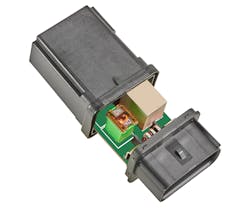You would have to live under a rock not to see the tremendous change the automotive industry is undergoing. From advanced driver-assistance systems (ADAS) to fully autonomous vehicles, OEMs are moving at lightning speed to keep up with the consumer and industrial demands.
Two megatrends that are part of this revolution—increased vehicle electrification and the move to autonomous vehicles—have significantly increased demands on the electrical architecture of the vehicle. Driven by consumer demand, technological innovation, and regulations, electrical systems must deliver more power to do more, often under extreme conditions. This raises performance expectations on every component in the electrical architecture, including power distribution boxes (PDBs).
However, as this revolution has evolved, the automotive electrical system and its components have remained relatively unchanged. To support today’s power-switching and circuit-protection requirements in the connected vehicle, as well as match the pace of change and need for great capacity, innovative technology is critical. Electrification of engine management, body control, lighting, steering, braking, safety systems, infotainment, and navigation all demand the latest tech in automotive electrical systems.
Greater Demand for Vehicle Electrification
What’s driving the demands for more electrification in today’s vehicles? Primarily, two factors: consumer demands and market trends; and regulatory and legislative mandates.
Today’s consumers insist on more from their vehicle than simply transportation. They want to interact with their vehicle similar to the way they interact with their smartphone—except in this case, they expect, for example, a wide range of infotainment, navigation support, and even wireless access. Market trends also contribute to the increased demand for electrification as ADAS become more complex, electric vehicles (EVs) and hybrid vehicles become more common, and with enhancements to tradition internal combustion engines’ electric superchargers and engine control systems to increase fuel efficiency.
The second factor, regulatory and legislative mandates at both the federal and state levels, adds complexity. Mileage requirements, as well as emissions and CO2 standards demand lightweighting in every system—including electrical. Safety systems, including cameras, radar, LiDAR, and sensor fusion systems that support ADAS, all must be reliable and perform under the most extreme conditions, with built-in redundancy to prevent failure.
How OEMs Will Meet These Demands
Automotive and transportation OEMs seek innovative solutions in every system, including electrical, to meet the demands fostered by these megatrends. To manage and deliver the power required by these complex technologies, OEMs need solutions beyond the main PDB. They must offer additional circuit protection that’s smaller, lighter, customizable, and flexible, and are reliable and durable in every application.
A new technology has been devised to meet these power-switching and engineering demands, offering a new approach to PDBs. Traditionally, the PDB simply provides a fused pathway for power in the vehicle electrical system. However, it doesn’t accommodate the complexity of the growing number of in-vehicle systems requiring power, including safety, engine control, and enhanced navigation and infotainment among others. What if the PDB had a different form factor? One that could accommodate the new connected vehicle’s design needs? Most of these challenges would go away.
Enter the Micro Power Distribution Box (Micro PDB or µPDB), with its much smaller footprint, providing a flexible advantage in vehicle electrical-system design. The µPDB is a connector-based rather than hardwired solution, eliminating cut leads and crimped wires. Further, it’s customizable and offers OEMs an effective way to make changes to electrical architecture during model year refresh cycles, when it’s necessary to add new or enhanced technologies. It’s also an applicable solution for emergency and commercial vehicles, when add-on equipment is essential.
Due to its much smaller footprint and customizability, the connector-based Micro Power Distribution Box (µPDB) brings greater flexibility to automotive electrical-system design.
Further, the µPDB is a completely sealed waterproof technology. Thus, it’s well-suited for use in safety systems, in which redundancy and failsafe performance is a primary concern when powering cameras and sensors that endure tough environments and extreme weather.
Meeting Traditional Challenges
In addition to satisfying the market’s latest demands, OEMs have traditional demands to fulfill as well. Where there’s electrical activity, there’s heat, and in turn thermal management becomes an important concern. Micro PDBs can be used to isolate high-current components from the main PDB—cooling fan relays, for example—for thermal management and optimized operation. They’re also a smart solution, providing the ability to add communication bus capability (LIN, CAN) within the system.
Cost-effectiveness is another common challenge for OEMs. Micro PDBs represent a significant cost-reduction opportunity over traditional solutions such as auxiliary boxes, fuse modules, and hang-off relays. Their smaller size provides flexibility in packaging technologies within the electrical architecture, and they’re lighter to support lightweighting. The modular design of Micro PDBs makes them easier to implement within vehicle platforms, and because they’re connectorized, their application is simpler within the vehicle architecture.
Today’s Revolution, Tomorrow’s New Normal
While the method of delivering and switching power within vehicle electrical systems has remained essentially unchanged over the decades, it’s currently being reinvented through innovations like the µPDB. As OEMs look for more flexible, lighter, reliable, and cost-effective solutions for power switching and circuit protection, the µPDB helps meet those demands as they relate to the current engineering revolution.
Moreover, as the megatrends driving the current revolution become the new future state, µPDB technology will support the industry’s move from electrification to fully autonomous vehicles (AVs) and support vehicle-to-vehicle (V2V) and vehicle-to-everything (V2X) communication.
Rand Wilburn is a Global Product Manager for Molex.


